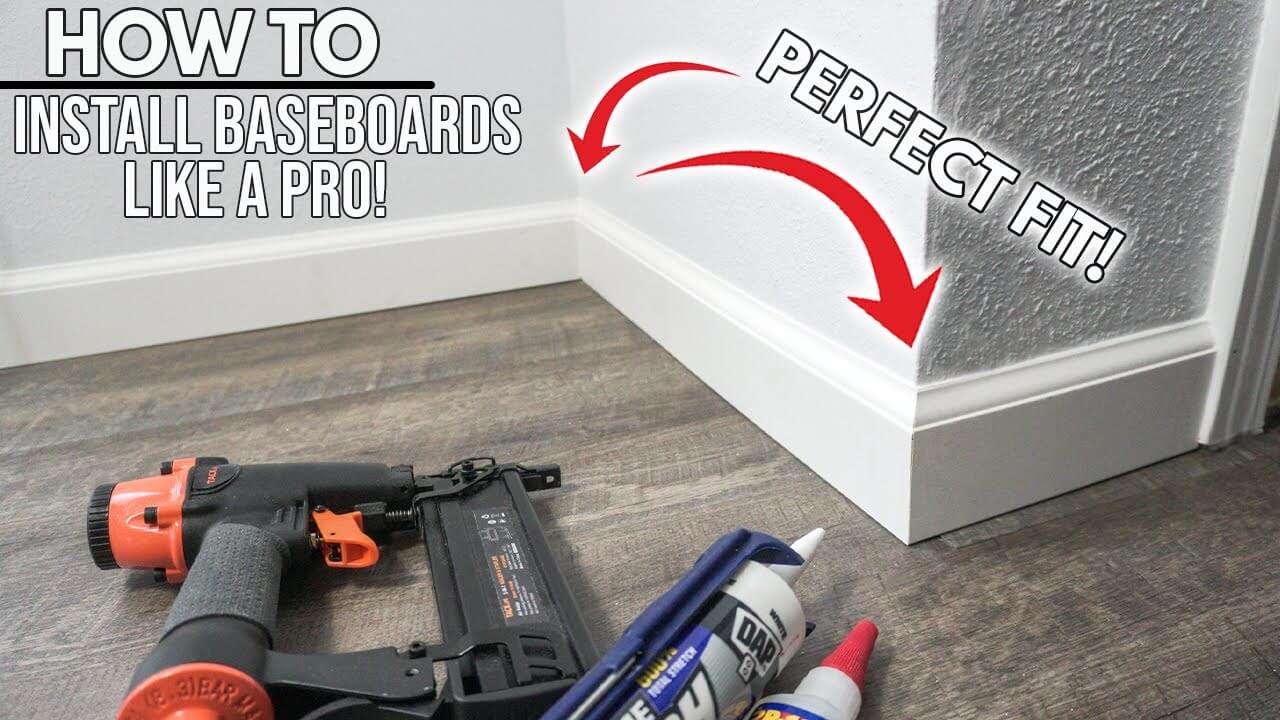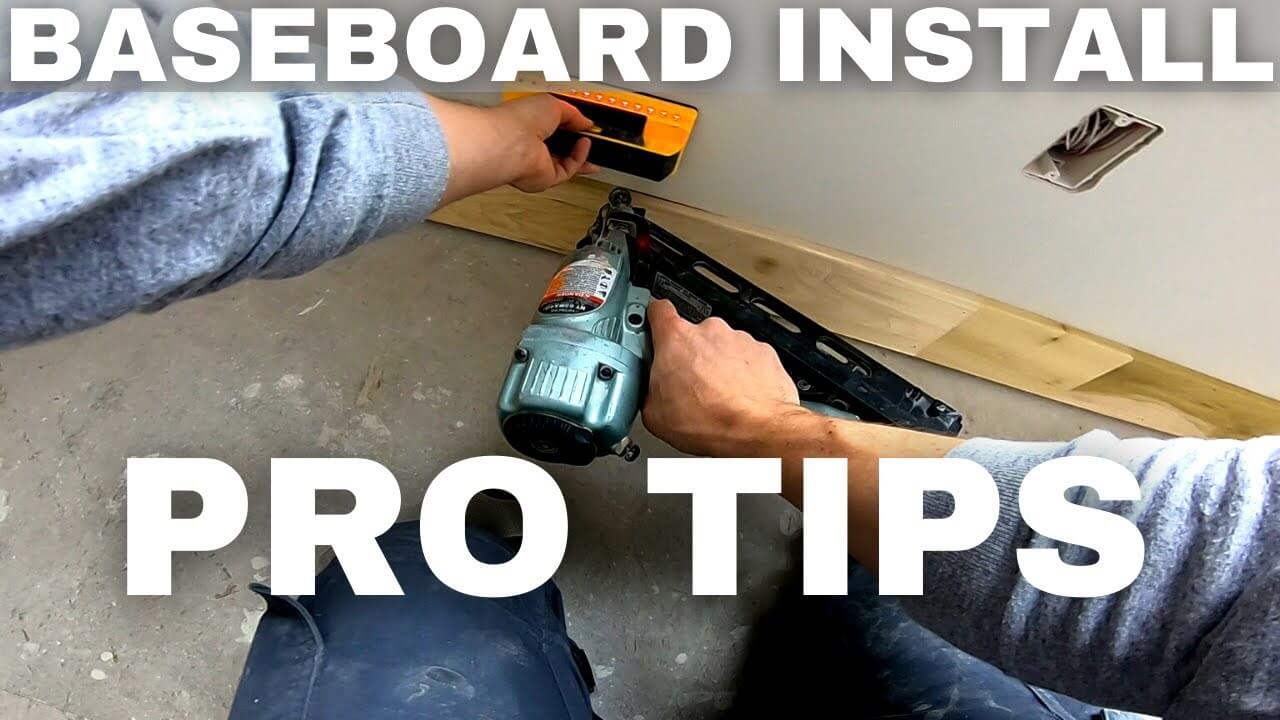How to Cut Trim With a Miter Saw to Absolute Perfection!
Cutting molding with a miter saw isn’t as difficult as it seems, especially if you follow our advice. If you’re new to using a miter saw, one of the most useful DIY skills to possess, is to be able to correctly cut a piece of trim using a miter saw.
In this article, you’ll learn the right way to accurately cut and fit a piece of trim for both windows and doors, baseboard trim, and even crown molding. We’ll touch on everything from miter cuts, shaving miters, coping baseboards trim, and much more.
If you follow this guide, the piece of trim you’ll be cutting will fit right every time if you adjust your cut to the precise angle of degrees in which your corner piece molding will be installed.
Prepare the Tools and Materials Beforehand
Most of what you’ll need for installing molding successfully is a decent sliding compound miter saw, a hammer or nail gun, a measuring tape, and or a combination square.
Oh yeah, and of course, some high-quality trim molding.
If you’ve got everything you need, you’re now ready to cut and fit any piece of trim by simply following these tips below.
Before you get to work, make sure you have everything you need. If you’re new to this, you might forget some of the things you require, so we made a bucket list of necessary items.
You don’t need a lot of tools or materials, but making use of a dual bevel miter saw will make life a lot easier for you.
That said, a single bevel miter saw will still get the job done, although you will have to flip the piece of trim you’re working with every now and then if you’re using the latter.
Materials: You’ll need a trim, glue, shims, brad nails, and molding.
Now, the list of tools you need is a little bigger, so here’s a neat bullet-point list, plus some additional safety tips:
- Eye, nose, and ear protection is a must. You can wear just about any protective eyewear as long as it’s not paper-thin, and some noise-canceling headgear. A dust mask is also necessary to keep the sawdust out of your nostrils.
- Ideally, you might want to get your hands on an air compressor if the nail gun you’re using is air power.
- A good quality (air or cordless) brad nail gun would be beneficial, or if you don’t have one, use a hammer and punch.
- I’d also suggest a tape measure, stud finder, some 120 – 180 grit sandpaper, and a microfiber cloth.
- The next item I recommend is a combination square to accurately measure your corners as you go.
- A Caulking gun for finishing the trim is also an essential item, although don’t break the bank here with some cordless caulking gun, the cheaper the better.
- Finally, you need a compound or sliding compound miter saw. A coping saw could be useful, but it isn’t 100% necessary.
Note, you’ll also want to make use of a quality blade on your miter saw. A carbide-tipped miter saw blade is the best for trimming. Get a blade that has at least 60 teeth, and you’ll be good to go
Safety Tips to Consider
While this part of the article might be the most overlooked, when it comes to operating power tools, especially saws, taking a few moments to consider the task at hand should really be paramount.
While health & safety is normally an afterthought for most DIY enthusiasts, professional contractors take it very seriously, hence the reason majority of injuries happen at home, not at work.
So be a professional (even if you’re not) and err on the side of caution by being aware of the tools you are working with at all times.
Always utilize a miter saw while working off of a stable base or use a miter saw stand if you have access to one. Keep your base station clear of any off-cuts left behind, and stack the trim you’re working with neatly to prevent a potential tripping hazard.
Sounds like common knowledge, right? Well, that’s because it is.
Note, if you’re in an area where the public or even your family members can access, a basic work-in-progress sign could be useful, too.
Getting Started
So now you’re ready to break out the big guns and effortlessly make the cuts necessary to install the perfect piece of trim. Since there are many different techniques depending on the trim, we’ll separate the processes to cut and fit trim into separate sections for better clarity and understanding.
What Angles do You Cut Trim at?
The one sign that indicates that your trim molding isn’t installed to the highest of standards, is a defective-looking corner piece of trim. While optimizing your trim molding to reveal elegant-looking angles and pristine corner pieces might seem daunting, you’ll get the hang of it with the right knowledge and tactics.
You should be looking to cut the majority of your angles for interior trim are 90° and 135° degrees. If it’s your standard inside corner at 90°, you should cut each piece of trim at a 45° angle so that when the two pieces of trim form a corner piece, you have yourself a 90° angle.
So your first step to making this 90° corner cut is to set the angle of your miter saw to 45° and cut both bits of trim accordingly. Now that you’re developing a base understanding of angles and their relevancy regarding miter saws, let’s dive a little deeper with some more complex tips and tricks.

Shimming and Shaving Miters
Sometimes, when you cut miters for sections of baseboard trim molding, you’ll notice that the trim isn’t quite fitting well.
This is quite common, and it has nothing to do with your miter saw or the way you’re operating it. The fact is, most walls aren’t a true 90-degree right angle.
The secret to fitting your trim flat against the wall to display the perfect-looking corner piece of trim is to shave the miter cut so the trim can fit the off angel better.
This can be done the simple way, just by slightly altering the angle of your saw and molding the pair. In fact, this method is simple for those saws which allow for these micro-adjustments, and expert carpenters, of course.
Another way, which is more novice-friendly, is to put a shim against the fence of your miter saw. This will alter the angle slightly, just enough to make a fitting cut. If you place the shim further away from the miter saw blade, it will allow small adjustments. Alternatively, if you position it closer, you can make big adjustments.
Always keep in mind that you need to cut both pieces identically so they can fit the corner angle correctly.
This sounds great and easy in theory, now let’s do it in practice step by step following these important tips:
Step 1
First, you need to do a micro-adjustment. Use a tiny shim (1/16 inch or smaller) against the fence of your miter saw, as far away from the blade as possible.
Step 2
Then, you need to slide the molding closely to the shim and against the fence of your miter saw, this time close to its blade. Keep it this way when you’re making the cut.
Step 3
Don’t forget to remain cautious and keep your fingers well away from the blade, preferably holding on to a solid base.
Tilt Trimming Window or Door Jambs
Window and door jambs don’t always fit with the wall. If a jamb is poking out, you can nail the trim to it, then put a shim in between the drywall and the trim, finally nailing the trim to the wall. If you’re worried about the gap, just use some paint and caulk to hide it.
Inset jambs require a different solution. In this case, you need to remove some drywall in order to extend the trim to the jamb and wall tightly. This isn’t all. Even if you use a 45-degree miter, it won’t fit. The molding needs to be tilted down so it can meet the jamb.
You need to tilt the trim to your miter box, replicating the angle of it resting against a wall. Only then can you use the regular 45-degree miter cuts.
Follow these instructions and tips and you’ll be left with exquisite-looking trim:
Step 1
First, you need to cut a shim so it fits under the straight edge alongside the corner of the drywall. This shim will serve you like the rise of the molding’s outer edge before you cut it.
Step 2
Then, you need to trim the drywall using a sharpened utility knife. You’ll know it’s done when the molding no longer rocks. You can also use a hammer to make the drywall flat. It’s done when the molding is tight against the drywall and jamb.
Step 3
Finally, use a shim to elevate the outer edge of your molding. Then use the miter saw to cut a 45-degree miter. Do the same with the opposite miter.
How to Cope Baseboard Efficiently
You won’t perfect the art of using a miter saw to cut trim until you’ve done some baseboard coping. This is actually more efficient than mitering the inside corners.
Coping tall baseboards is hard if you use just a coping saw as you’ll have to be super precise and maintain a steady hand, which is why miter saws are actually better at this.
Without much theory crafting, follow these detailed steps and creative tips to cope with baseboard perfectly:
Step 1
Start off with standard coping. Use a 45-degree miter on the baseboard. With a miter cut, you’ll get a profile guiding your cope cut.
Step 2
Next, turn the board you’ve mitered facing down. Micro-adjust the angle (up to 15 degrees) and saw along the straight part of the bevel cut. Hold the blade slightly out of line. Make sure the blade stops before you lift it up.
Step 3
Use a coping saw to saw the rest of the profiled material. Use a 30-degree angle to make a back bevel. This will make the fit easier.
How to Close Gaps on Inside Corners
Coping corners to a ‘T’ doesn’t make a difference if you have floors or walls that are uneven.
Follow these instructions and useful tips for closings gaps on inside corners:
Step 1
First, you need to check if the base fits correctly. Straight sections usually don’t fit all that great.
Step 2
Remove the square base at the bottom and close the gap with a drywall screw. It should go about ½ inches deep in the wall. Do a few tests and move the screw until you make a perfect cope fit.
Step 3
Finally, scribe the gap using a tiny compass which will mark the excess wood. File to the line you just marked.
How to Fit the Outside Corners
Outside corners are also difficult to fit. You need to make precise baseboard markings instead of being overly reliant on measurements.
Follow these steps for cutting trim effectively utilizing a miter saw on the outside corners with these insightful tips:
Step 1
First, you need to make a marking on the outside corners with a utility knife. This will give you better visibility than a mark with a pencil. Mark the opposing baseboard as well.
Step 2
Cut both sections of the board at a 45-degree angle, but leave a 1/8 of an inch after the mark.
Step 3
If your miter is open at the front, increase the angle for cutting just a degree or two, and cut again on both sides. Carefully remove very little from both boards.
Step 4
If the miter is open at the back, you need to slightly reduce the angle. Cut again on both sides, only a little outside the marks. Nail the boards back into their place.
How to Fix Dead Ends
Trims can often have dead ends, on chair rails, window aprons, etc. Sure, you can chop them up and use some nails, but that just doesn’t look right. You can use a better way, giving your trim that final perfect touch.
Follow the steps for these tips to fix dead ends on trim:
- The trick is to leave the cut slightly incomplete. You can cut the angle with your miter saw, with a slight mitered return, just don’t cut off the trim completely.
- Here’s the catch. Use a utility knife to get through the slight remainder of wood. This will prevent tear-outs, and also you won’t have the risk of this piece of wood flying up and accidentally hitting you.
- Finally, use a powerful and quick glue to glue in the return wood. It’s best to shop for specialized wood glue. Any brand will do the trick as long as it’s made for this purpose. Ask for cyanoacrylate glue, that’s what it’s called
When you fix a dead end like this, your trim moldings will exhibit a perfect-looking finish, showcasing your master craftsmanship skills courtesy of every superb cut and well-crafted corner of your project.

In Conclusion
There you have it. Now while it’s entirely possible to cut baseboard trim without a miter saw, using a miter saw to do so really does streamline the entire process. Honestly, cutting baseboard with a miter saw is where these tools excel.
Well, we hope this article covered everything you need to know to cut and install trim with a miter saw, including dead ends, outside corners, inner corners, coping baseboard, shimming and shaving miters, and trimming jambs.
Miter saws are extremely safe if you’re careful and you know what you’re doing. Just remember to never move your fingers too close to the blade; keep them at least six inches away and don’t cross your arms over when maneuvering the saw.
Lastly, before you commence your trim project, equip yourself by purchasing all the necessary tools and materials. While there are other power tools you can use to cut trim as a table saw or a jigsaw, cutting trim with a miter saw vs table saw is incomparable.
A sliding compound miter saw will go a long way in developing your skills as a craftsman and prove to be a great investment for your workshop. Plus miter saws are the power-perfect tool for cutting baseboard trim to showcase a flawless-looking finish.





